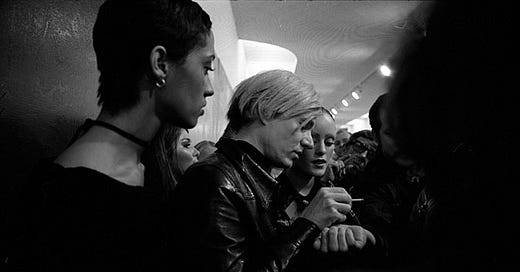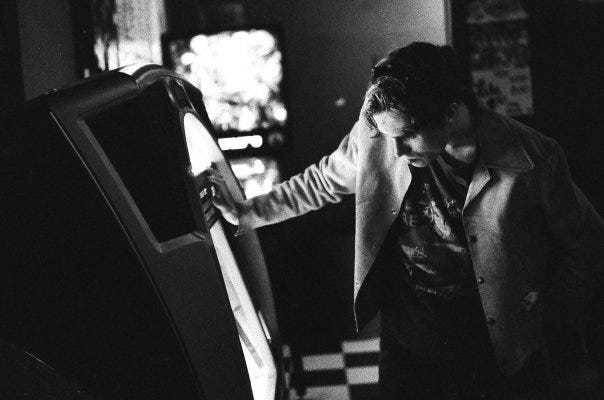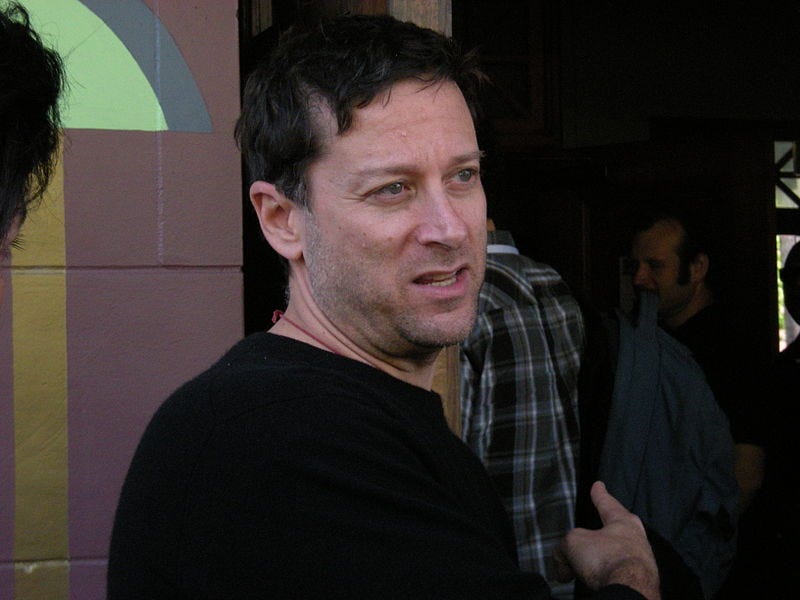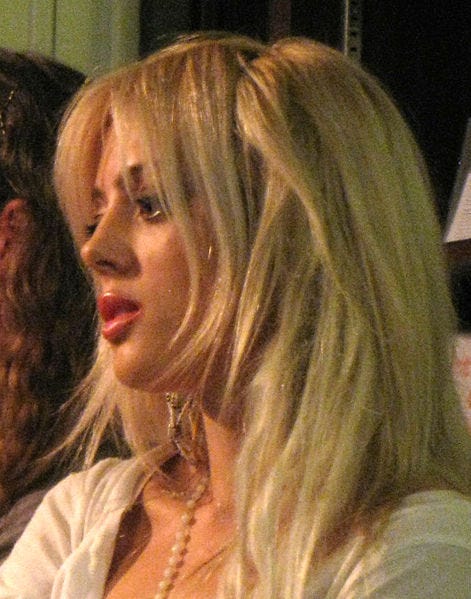Andy Warhol signing autographs.jpg/ Wikimedia Commons
In 1990, eight years after its publication, the book Edie: An American Biography, the oral history of the life of 1960s Warhol “superstar” Edie Sedgwick by the author Jean Stein (RIP), captured my attention. During that pre-internet period, I would attempt to track down old magazine articles about Sedgwick in libraries. After considerable effort I would often locate the correct bound periodical volume only to discover that some prior patron had taken an X-acto knife to the images. As for her films, The Andy Warhol Museum seemed to keep tight control over them; I was only able to see Poor Little Rich Girl when it was screened at the University of Texas at Austin (although curiously, soon after I finished the book, I stumbled upon the non-Warhol-affiliated film Ciao! Manhattan on a local Colorado Springs TV channel). While visiting NYC I stopped into The Museum of Television and Radio (now The Paley Center for Media) and searched for footage of her; while I couldn’t locate any, I did find a TV performance by The Velvet Underground (and immediately afterward bumped into Lou Reed— in the flesh!— at Dean & DeLuca).
Velvet Underground & Nico publicity photo (retouched).jpg
Warhol’s films were entirely unscripted, and there were no discernible plots. They caught his “superstars” hanging out and ad libbing dialogue that was often unintelligible. Sedgwick became famous for no other talent than being her photogenic self.
Warhol’s oeuvre inspired an interest in black and white photography in me; in 1994 I took a photography class and began shooting photos of people out at night, which I painstakingly developed in a darkroom. Within two years, with the rising popularity of digital cameras, I abandoned my hobby. I intuited that photographs would become less special as they became easier to produce, manipulate, and distribute, but in those early days of the internet I had no idea what lay ahead.
In 1999, Josh Harris, the son of a CIA agent and founder of the early streaming content service Pseudo.com, set up dozens of young people in a New York City bunker in which their every move was broadcast online, predicting the explosion of reality television as well as the advent of social media (Harris’s experiment is explored in Ondi Timoner’s 2009 documentary We Live in Public, while the entire arc of his career is detailed in the book Totally Wired: The Rise and Fall of Josh Harris and the Great Dotcom Swindle). Harris has been called the "Warhol of the Web."
Josh Harris 02.jpg/ Wikimedia Commons
1973’s An American Family, featuring Sedgwick/Warhol fan and eventual Warhol associate Lance Loud, is considered America’s first reality television program, but the genre really gained steam following the debut of The Real World in 1992 and then became wildly popular in the late 90s/ early 2000s with shows like Big Brother and Survivor. It was around this period that I came across numerous references to the statement that “in the future, everyone will be famous for 15 minutes” that is attributed, perhaps mistakenly, to Warhol.
Lance Loud 1973.JPG/ Wikimedia Commons
The online world and its accompanying user-generated content greatly accelerated in the aughts with Web 2.0. The social networking site Friendster launched in 2002 (yes, I had a profile) and MySpace launched in 2003. YouTube officially launched in 2005, the same year podcasts became available. In 2006, Facebook opened to the general public. The first tweet was sent in 2006. The iPhone debuted in 2007. Instagram launched in 2010. TikTok took off in the U.S. beginning in 2017.
These new forms of media have resulted in an ongoing glut of celebrities who are famous for being famous, but Edie Sedgwick continues to exert a magnetic pull. Yet today’s fangirls no longer have to do much legwork, or search through museum and library collections, or rely on serendipity to satisfy their curiosity. Images of Sedgwick abound online; one can find a Merv Griffin interview with her as well as other footage on YouTube; Ciao! Manhattan is available on DVD; and streaming versions of Vinyl and Outer and Inner Space are available at the warhol: TV.
In August this past year, thirty-two years after I discovered Edie: An American Biography, Farrar, Straus and Giroux published As It Turns Out: Thinking About Edie and Andy by Sedgwick’s oldest sister, Alice Sedgwick Wohl. Wohl’s book covers much of the same ground as Edie, but in the final chapter, Wohl insightfully ruminates on Sedgwick’s appeal. She concludes that Sedgwick was pure image and that Warhol was prescient in detecting the coming era in which image would be king. She connects Warhol’s work to selfies and influencers and, of course, the Kardashians. The waifish and self-destructive Cat Marnell, a one-time beauty writer for the online magazine xoJane, seems to have fashioned her life explicitly in the Sedgwick mould.
Cat Marnell at Housing Works Bookstore Cafe October 2012.jpg/ Wikimedia Commons
Meanwhile, the paper publications that helped make Sedgwick famous have been increasingly eclipsed by digital media, as have DVDs, and digital audio is exerting pressure on physical audio. What will become of all those library stacks currently housing periodicals, DVDs, and audiobooks? Perhaps they will make way for self-service media studios.
To promote viewpoint diversity, Heterodoxy in the Stacks invites constructive dissent and disagreement in the form of guest posts. While articles published on Heterodoxy in the Stacks are not peer- or editorially-reviewed, all posts must model the HxA Way. Content is attributed to the individual contributor(s).
To submit an article for Heterodoxy in the Stacks, send an email with the article title, author name, and article document to hxlibsstack@gmail.com. Unless otherwise requested, the commenting feature will be on. Thank you for joining the conversation!









You are describing a broader trend in what could be called clutter reduction. I am a retired engineer. While downsizing recently I was sorting through a box of old letters from the seventies and eighties with the object of selecting some to pass on to my daughter. I have a much older set passed on to me by my father, including a number of handwritten letters from the 1890s from his grandfather. It occurred to me: I wonder if my daughter will have any such letters of her own to pass on to her children? I wondered if she had ever even received even a single physical handwritten letter? They no longer even teach handwriting in schools.
The deluge of digital media seems to be doing two things: the "deluge" part has made every single person a photographer with a portfolio of tens of thousands of photos (and now movies). Storage is so cheap that we don't ever cull them. So what builds up is an ocean of mediocrity and banality that no one has the time to swim through looking for what is special. What valuable "signals" undoubtedly exist within are buried in "noise".
The "digital" part is tricky. Formats keep changing. How many of you have run into the problem of being unable to view/play the older archives? Digital discs or tapes that no longer work? Players no one has anymore? Corrupted media? I can still play every single one of my vinyl records. But I am finding an increasing number of my CDs won't play. Copy them onto hardrives and into the cloud, you say. Then there are those inevitable hard drive crashes, cloud failures, account terminations, backup failures, accidental deletions of entire corpuses of imagery, email archives that for weird reasons are unrecoverable and suddenly one realizes it's all gone forever. Like it never existed.
Archeology talks about how little we know about the lives of early people who didn't leave durable artifacts. Are we creating a modern "dark age" of which little can be known or said in a thousand years time? They will call it the plastic age.Thats durable. But who were these people?
Where should your photo albums and hand-written letters go? Your Local Archive might want them? Perhaps future humans will judge our "Plastic" age by the increasingly rare independent print and other analog media, especially vinyl. The enthusiasts (and Libraries and Archives) collecting zines and ephemera will be the voice of the 'Late 20th and early 21st century'. What we keep and what we discard will define us for future generations. So instead of selecting for what you want your Daughter to know of you, choose what you want someone in 2122 to know of you, if anything. Most humans for most of history are now completely anonymous to us. This ought to be a liberating idea, but it also means is that the lessons we ought to learn from the recent past will be lost to all of us. Mistakes we are already repeating thanks to the "Right side of History" hubris created by tech echo chambers that equate a difference of opinion with bigotry. A 'De-cluttered' version of history is what we are currently trying to unlearn; at the same time, there is an alarming trend for 'Activist' library workers to 'de-select' the voices and ideas that might expose them to a content challenge. Truly revolutionary voices from the last 50 years are being erased in ways that may mean they are lost forever. Our memory institutions cannot keep up with the cost of maintaining access to constantly changing tech. The Internet Archive can only do so much. I relish the notion that, much like the sacred shopping list of A Canticle for Leibowitz, future historians will view us through the miraculously intact personal print library of a Star Trek obsessed hermit living in a remote wilderness. The superstars of the moment will be long forgotten.